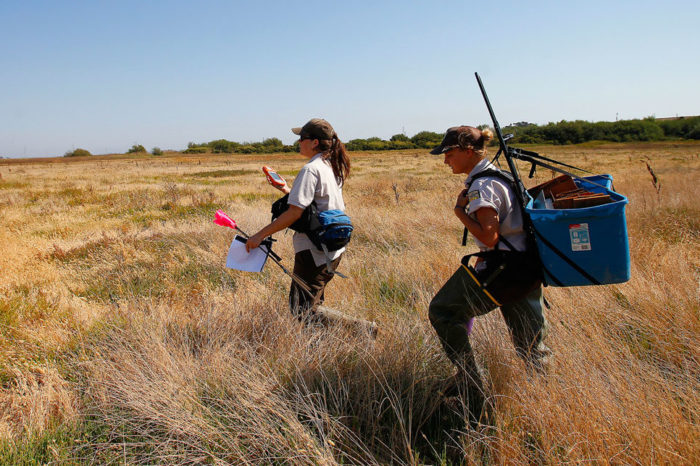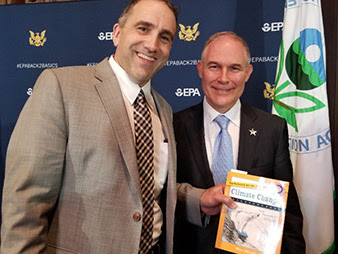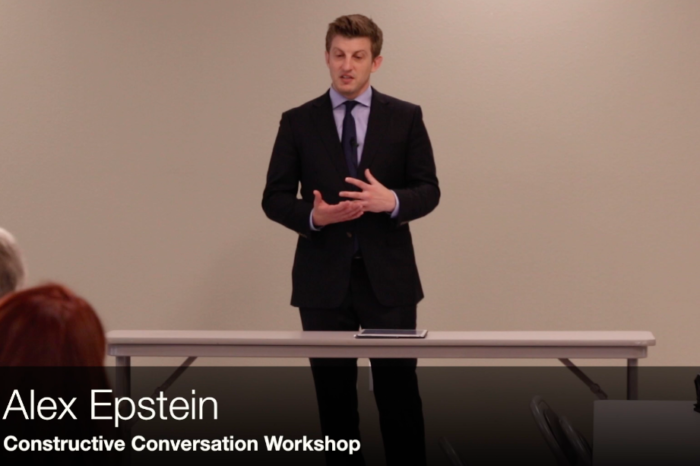The Government Relies on Flawed Data to Determine Endangered Species
Americans who live in or near a community built around a lake should be careful about stepping outside to mow the lawn if the temperature isn’t just right and the grass isn’t a certain height.
They should keep pets indoors. They should forget about using weed killer. And they should be prepared to pony up a steep homeowners association fee.
That’s because there may be snakes in the area protected by the Endangered Species Act of 1973, which imposes stiff penalties and fines for violating its rules and restrictions.
Rob Gordon, a senior research fellow with The Heritage Foundation, discovered the situation while researching the U.S. Fish and Wildlife Service’s 1999 decision to list the Lake Erie water snake as a “threatened” species.
The Fish and Wildlife Service estimated the population of that particular water snake to be somewhere between 1,530 and 2,030 at the time. But just a few years later, the agency revised it to 5,690.
The government either made a “substantial underestimation” with the initial listing or the water snake had “a truly miraculous population growth rate” in a short time, Gordon observes in a recently published research paper that finds the listing process under the Endangered Species Act to be riddled with “erroneous data.”
Gordon concludes that “essentially half of the species” identified by Fish and Wildlife Service officials as “recovered” never should have been listed in the first place.
The regulatory fallout for developers, homeowners, and business owners who run up against the endangered species law is the same regardless of whether federal officials used sound science or flawed methodology, Gordon told The Daily Signal in an interview.
“Once a species is listed, it is regulated and the way it’s regulated doesn’t vary dependent upon the quality of the data the agency used,” Gordon said. “If one listing is legitimate and another listing is illegitimate based on erroneous data, the practical consequences are the same to the property owner or the business owner. He or she still faces the same restrictions whether or not these restrictions are legitimately based on science.”
After reviewing the Fish and Wildlife Service’s documentation in the case of the Lake Erie water snake, Gordon found the agency worked to impose “surreal regulatory hurdles” against a developer who sought to build seven houses on 15 acres.
The Fish and Wildlife Service called for easements to be placed on over five acres of lakefront property that would be donated to a nonprofit organization. The agency also sought a $50,000 “contribution” from the developer to cover construction of a hibernation habitat for the snakes, and creation of a homeowners association that would impose additional restrictions.
‘Federally Funded Fiction’
The case of the Lake Erie water snake “is a small example of the heavy-handed regulatory process for just one of the nearly 1,700 listed species to which landowners and businesses are repeatedly subject across the nation,” Gordon writes in his paper.
Although the government delisted the snake in 2011, numerous restrictions popped up in the meantime.
Homeowners association restrictions stipulated that residents make sure no snake was within 20 feet when applying weed killer to poison ivy, that they not allow cats outside, and that they abide by seasonal height and temperature guidelines for mowing lawns. Collectively, residents also had to provide up to $18,750 for snake research, and allow researchers to have access to their properties.
“This seems really over the top, doesn’t it?” Gordon asked in the interview with The Daily Signal. “And keep in mind that the snake’s actual population numbers were probably undercounted in the first place.”
Gordon describes the recovery figures that Fish and Wildlife officials cite as “federally funded fiction” that dramatically inflate the number of species that genuinely were endangered and subsequently preserved.
“With all the ESA’s costs and burdens, it should perhaps come as no surprise that the U.S. Fish and Wildlife Service is fabricating success stories to cover up this unsustainable mess and substituting fluff for statutorily required reporting regarding the recovery program,” he writes of the law in his paper.
The errors that result in listing species that are not genuinely endangered stem in large part from the “low bar for scientific data” set by the agency, Gordon concluded.
The Endangered Species Act calls for the “best available scientific and commercial data” to be used in the listing process. But here’s the problem, from Gordon’s point of view: Fish and Wildlife officials interpreted this directive to mean the information underpinning a listing doesn’t need to be complete or accurate.
“The agency has not set a high enough bar and sometimes they are using scant or even nonexistent data to list species,” Gordon told The Daily Signal. “They are using speculation and surmise as opposed to verifiable data, and in some instances they won’t even share the data. It’s no wonder that consequently all sorts of species are erroneously listed. That’s what happens when you have weak data standards.”
How bad is the problem?
Of 1,662 plants and animals listed by the Fish and Wildlife Service as either “endangered” or “threatened” in the past 45 years, the government had removed 68 before Gordon published his paper in April.
Of those 68, 11 were removed from the list because they had gone extinct and 19 were removed because of errors in the original data. That leaves 38 species delisted because they were “recovered.”
Taxpayers on Hook for ‘Deceitful Practices’
Under the Endangered Species Act, the conservation process involves “the use of all methods and procedures which are necessary to bring any endangered species or threatened species to the point at which the measures provided … are no longer necessary.”
Endangered species are considered to be at the brink of extinction, while threatened species are considered likely to be so in the near future.
Gordon initially determined that “almost half” of the 38 species listed as “recovered” were actually “false recoveries” because they were based upon original data error.
However, since his paper was published three more species have been delisted and he has concluded that two—the lesser long-nosed bat and the black-capped vireo—were listed based on erroneous data.
For this reason, he now says “essentially half” of the species the Fish and Wildlife Service identified as recovered are not genuine recoveries.
Gordon says he also found other examples of “recovered” species that are really “mixed bags,” meaning the number of recoveries resting on erroneous data could be much higher.
(The full list of delisted species is available here.)
The Daily Signal sought comment from the Interior Department and the Fish and Wildlife Service on Gordon’s findings and whether Interior Secretary Ryan Zinke might consider his recommended reforms. Officials had not responded as of publication.
Unfortunately, U.S. taxpayers are footing the bill for “deceitful practices that portray mistakes as successes,” Gordon told The Daily Signal.
That’s because each listing sets in motion mandatory actions and government expenditures under federal law, he said.
For instance, according to Gordon’s paper, the Fish and Wildlife Service reported in 2014 that the “median cost for preparing and publishing a 90-day finding is $39,276; for a 12-month finding, $100,690; for a proposed rule with critical habitat, $345,000; and for a final listing rule with critical habitat, $305,000.”
“These are just the paperwork costs and the bureaucratic costs of listing species whether they were legitimately listed or if they were listed based on erroneous data,” he told The Daily Signal. “But they are a drop in the bucket compared to the costs borne by private parties such as companies, farmers, and ranchers who have to comply with all kinds of mandates and have to absorb the loss in the value of their land because of their inability to use it and other significant opportunity costs.”
Special Interest Groups Drive Litigation
Gordon points to restrictions the Fish and Wildlife officials sought to impose to protect the Lake Erie water snake as an example of excessively burdensome costs.
Gordon’s paper was the subject of a panel discussion April 25 at The Heritage Foundation where he was joined by Rob Roy Ramey, a wildlife biologist based in Denver, and Jonathan Wood, a lawyer with the Pacific Legal Foundation who specializes in environmental and constitutional law.
Ramey called for greater openness and transparency on the part of federal officials and suggested that all the data Fish and Wildlife officials use in their decisions to list species should be made public.
“That way we have a common currency of accountability available to the entire nation,” Ramey said at the Heritage event. Without access to the data, he said, “there’s no opportunity for reproducibility,” which means listing and delisting decisions may not be based on the best scientific information.
Ramey cited several examples of responses from government officials who resisted information requests. His personal favorite came from a “rogue recovery team member” who said:
U.S. Fish and Wildlife Service data was deliberately provided in a format that would not facilitate detailed analysis by those unfamiliar with the manner in which the data was collected.
Other examples included “the data you requested are proprietary,” “we are still using this data,” and “those data may no longer exist.”
Ramey warned that Fish and Wildlife officials who have “cherry-picked” and “fabricated” data to list species as endangered or threatened drew resources away from creatures in genuine need of protection, such as blue whales, California condors, rhinoceroses, and gorillas.
Wood, the lawyer with the Pacific Legal Foundation, a nonprofit headquartered in Sacramento, California, credited Gordon with research that shows how often examples of species recovery touted as successes for the Endangered Species Act “are little more than fake news.”
Special interest groups play a role in the listing process, Wood said at the Heritage event.
“What really drives the Endangered Species Act is litigation,” he said. “The reality is that the listing process is fundamentally broken, it is completely litigation driven, and it is a problem for administrations regardless of party.”
The Obama administration sought to develop a work plan to “seize some control back” over the listing process, Wood told the audience, so that key factors such as a species’ actual vulnerability would be considered and a listing would not be the result of “which special interest group is yelling the loudest.”
Potential Reforms for Interior Department
In his research, Gordon highlighted examples of listings where the initial count of a species population was dramatically off based on flawed methodology. He cited the Monito gecko during his talk at Heritage.
This lizard resides on Monito Island off the coast of Puerto Rico, which spans about 40 acres surrounded by 217-foot cliffs. The initial search Fish and Wildlife officials used as the basis to list the species in 1982 was organized during the day, when 18 lizards were found.
“The problem here is that the lizard is nocturnal,” Gordon told The Daily Signal. “So, if you are walking around during the middle of the day, you are not going to find it. The creature burrows down into rocks. In 2016, they finally did a proper survey during the evening and they came up with an estimate of about 5,000 to 10,000 geckos. That’s what you call a big difference.”
Gordon spelled out several potential reforms that the Trump administration’s Interior Department could embrace under Zinke’s leadership.
For starters, Zinke could issue an order directing the Fish and Wildlife Service “to accurately identify the data that forms the bases for removing or downlisting species,” Gordon writes in his report.
He also recommends that the agency correct the record and acknowledge instances where a species was wrongly declared to have “recovered.”
“Right now, the Fish and Wildlife Service asserts that the listings are driven by science, but in truth the listings are often driven by litigation and the scientific standards are so weak that they are often listing species as endangered when they should never have been listed,” Gordon said, adding:
The first step in correcting the problem is to admit that it exists. What needs to be done now is to go back and look at species that were claimed as recovered and to put your foot down and acknowledge that many of them were not really recoveries and they were based on erroneous data. Then, going forward, they need to make sure future listings are not based on speculation.
COLUMN BY
Kevin Mooney
Kevin Mooney is an investigative reporter for The Daily Signal. Send an email to Kevin. Twitter: @KevinMooneyDC.
Dear Readers:
With the recent conservative victories related to tax cuts, the Supreme Court, and other major issues, it is easy to become complacent.
However, the liberal Left is not backing down. They are rallying supporters to advance their agenda, moving this nation further from the vision of our founding fathers.
If we are to continue to bring this nation back to our founding principles of limited government and fiscal conservatism, we need to come together as a group of likeminded conservatives.
This is the mission of The Heritage Foundation. We want to continue to develop and present conservative solutions to the nation’s toughest problems. And we cannot do this alone.
We are looking for a select few conservatives to become a Heritage Foundation member. With your membership, you’ll qualify for all associated benefits and you’ll help keep our nation great for future generations.
ACTIVATE YOUR MEMBERSHIP TODAY
EDITORS NOTE: The featured image is of U.S Fish and Wildlife Service biologist Meg Marriott, left, trudging with intern Amy Newman to a trapping site for the salt marsh harvest mouse near California’s Napa-Sonoma Marshes Wildlife Area in this 2011 photo. The mouse was first listed as an endangered species in 1970. (Photo: Aric Crabb/Oakland Tribune/MCT/Newscom)
























